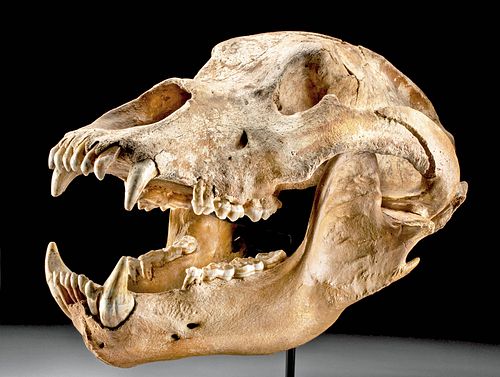Fossilized Pleistocene Cave Bear Skull
Lot 101a
About Seller
Artemis Fine Arts
686 S Taylor Ave, Ste 106
Louisville, CO 80027
United States
Selling antiquities, ancient and ethnographic art online since 1993, Artemis Gallery specializes in Classical Antiquities (Egyptian, Greek, Roman, Near Eastern), Asian, Pre-Columbian, African / Tribal / Oceanographic art. Our extensive inventory includes pottery, stone, metal, wood, glass and textil...Read more
Categories
Estimate:
$17,000 - $25,500
Absentee vs Live bid
Two ways to bid:
- Leave a max absentee bid and the platform will bid on your behalf up to your maximum bid during the live auction.
- Bid live during the auction and your bids will be submitted real-time to the auctioneer.
Bid Increments
| Price | Bid Increment |
|---|---|
| $0 | $25 |
| $300 | $50 |
| $1,000 | $100 |
| $2,000 | $250 |
| $5,000 | $500 |
| $10,000 | $1,000 |
| $20,000 | $2,500 |
| $50,000 | $5,000 |
| $100,000 | $10,000 |
| $200,000 | $20,000 |
About Auction
By Artemis Fine Arts
Oct 8, 2020
Set Reminder
2020-10-08 10:00:00
2020-10-08 10:00:00
America/New_York
Bidsquare
Bidsquare : Exceptional Antiquities, Asian, Ethnographic
https://www.bidsquare.com/auctions/artemis-gallery/exceptional-antiquities-asian-ethnographic-5796
Museum-worthy examples of Egyptian, Greek, Roman, Etruscan, Near Eastern, Far East / Asian, Pre-Columbian, African / Tribal,Oceanic, Native American, Spanish Colonial, Russian, Fossils, Ancient Jewelry, Fine Art, so much more! Artemis Fine Arts info@artemisfinearts.com
Museum-worthy examples of Egyptian, Greek, Roman, Etruscan, Near Eastern, Far East / Asian, Pre-Columbian, African / Tribal,Oceanic, Native American, Spanish Colonial, Russian, Fossils, Ancient Jewelry, Fine Art, so much more! Artemis Fine Arts info@artemisfinearts.com
- Lot Description
Ancient Europe, Romania, Pleistocene epoch, ca. 1.2 million to 24,000 years ago. Intimidating but also awe-inspiring, the fossilized skull of a European cave bear (Ursus spelaeus) with a full set of teeth. The bone surface is a weathered white with yellowing areas. This bear was probably full grown when it died as evidenced by the worn-down molars. Prehistoric humans did indeed hunt these massive bears and venerated them as deities. A bear skull, like this one, has even been discovered in an ancient cave shrine! Size: 18.25" L x 9.25" W x 10.5" H (46.4 cm x 23.5 cm x 26.7 cm); 14.5" H (36.8 cm) on included custom stand.
Enormous cave bears were first described in 1774, and scientists at the time thought their huge remains might be those of polar bears. Later scientists realized that they were once part of the group of megafauna that roamed Ice Age Europe - alongside mammoths, woolly rhinos, giant deer, and lions - and males of the species could be fifty percent larger than modern day grizzly bears. Ancient humans were aware of the animals and painted them on the walls of caves. Despite their fierce appearance, cave bears had a mostly vegetarian diet, and ultimately went extinct during the Last Glacial Maximum ca. 27000 to 24000 years ago, when the vegetation they relied upon disappeared. Despite their name, these bears only inhabited caves during their hibernation period through the harsh Ice Age winters. Many skeletons have been discovered in caves where the bears passed away peacefully in their sleep.
Provenance: private Hagar collection, Wildwood, Missouri, USA
All items legal to buy/sell under U.S. Statute covering cultural patrimony Code 2600, CHAPTER 14, and are guaranteed to be as described or your money back.
A Certificate of Authenticity will accompany all winning bids.
We ship worldwide and handle all shipping in-house for your convenience.
#159712Cranium repaired from approximately five pieces with minor resurfacing over break lines. Lower mandible reattached. Large chip from lower canine tooth. Surface weathering, cracks, and losses from the peripheries as expected with fossilization, but overall, good preservation with the teeth in great condition!Condition
- Shipping Info
-
All shipping is handled in-house for your convenience. Your invoice from Artemis Gallery will include shipping calculation instructions. If in doubt, please inquire BEFORE bidding for estimated shipping costs for individual items.
-
- Buyer's Premium



 EUR
EUR CAD
CAD AUD
AUD GBP
GBP MXN
MXN HKD
HKD CNY
CNY MYR
MYR SEK
SEK SGD
SGD CHF
CHF THB
THB















